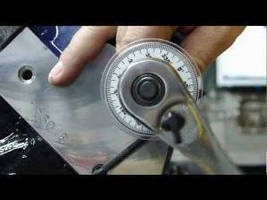Capturing and Simulating Rotational and Jitter Angle-Based Measurements

ADwin Data Acquisition Systems for Real-Time Measurements
CHESTERLAND OH - Capturing and simulating the high-speed rotations involved in automated machines and test rigs often plays a major role in industrial applications. Common requirements are accurate speed measurement over a large range of operation, detection of speed changes, capturing jitter, jitter simulation, and angle-based data acquisition. The Applications Specialists at CAS DataLoggers have put together this article to present some practical approaches to accomplishing these tasks.
Accurate speed measurement and frequency measurement over a wide range
Speed signals are usually generated from angular position signals generated by incremental encoders which provide an output in the form of pulse sequences, where the number of pulses per unit of time corresponds to the rotational speed. At low rotational speeds, the period measurement of the digital speed signal requires a very precise measurement method. This is measured using a high-frequency reference clock signal (clock speed= >20 MHz) which is used to calculate the time from rising to rising edge of the speed signal, from which the period and speed can be calculated. With increasing speed, this measurement becomes increasingly less accurate as the ratio of the measurement clock speed to the speed-dependent encoder signal decreases. To solve this problem at high speeds, the number of pulses over a fixed time interval will provide increased accuracy. Interestingly, in the mid-range, a combined frequency/period measurement is necessary to achieve acceptable accuracy. Here, the number of pulses N of the speed signal along with the N pulse period duration is recorded and then divided to get the period per individual pulse, resulting in a high accuracy measurement in the intermediate range.
One difficulty remains, however, because one cannot assume that the incremental distance between the angle marks on the incremental encoder is exactly the same. Incremental linearity errors are common, which challenge the engineer to make further considerations regarding speed detection. One possibility is as described above, where the speed is measured over a period of N pulses, which results in an averaging over an angular range. The best results can be obtained by averaging over a full rotation, although even here the speed can be calculated several times during one revolution.
This is actually very simple: for each pulse angle, the value of the period counter clock is stored in a table. On the following rotation, the difference between the new measured value of the clock and the value for the corresponding location recorded on the previous revolution is calculated to determine the speed. Then the new value of the period counter is stored in the table for the measurement during the next revolution.
A continuous recording of a speed variation is relatively easy to make by measuring the time period measurement for each individual complete revolution. In the case where both the speed of revolution and the variation of speed over a longer period are of interest, the data can be directly evaluated online and analyzed by the processor of the ADwin system for statistical information such as minimum, maximum and average values.
Simulation of angle-dependent quantities
The key feature of an ADWIN system is its local processor, which allows users to process each sampled measurement point to perform control even at high speeds. This capability is the basis for building a 'jitter test.' For example, an electric motor can be controlled via the ADwin's analog outputs, using the rotation of the shaft to reproduce the behavior of the crankshaft of an internal combustion engine. This is used to test components such as alternators, harmonic balancers, transmissions, timing belts, etc. The electric motor simulates the rotation of an internal combustion engine, with behavior that mimics the characteristics of real engine-based parameters such as the number of cylinders (3,4,5,6,8 etc.), load and acceleration or other rotational phenomena, which can be continuously adjusted via the ADwin's software.
In this application, the periodic rotational movement can be generated from an array where 360° of rotation is broken into 3600 individual nodes allowing a resolution of 0.1 degrees. The calculation of the value to be output at each position is typically done in an initialization phase; for example an array of values can be loaded into the ADwin system from a table previously defined on the PC such as the output of a simulation tool. The table will contain the value for each 0.1 degree step and the program set to loop such that when the end of the table is reached, the program jumps back to the top of the table to read the next point until the number of test cycles (revolutions) is reached. During the test should a change in the amplitude, offset or other characteristic be desired, it is not necessary to calculate a new table, but rather it's enough to apply a calculation to the values in the table to determine a new output value for each individual output step.
This procedure applies for normal combustion engine operation. However, if users need to simulate additional non-recurring rotations, for example when starting the engine, the table can be made correspondingly larger and can contain many more values. With more than 32MB of memory, the ADwin system can simulate the startup of an engine from a speed of 600RPM generated by the starter motor to normal operation with an angular resolution of 0.1° and still allow a test sequence of more than 440 seconds.
Both the continuous and non-periodic modes can be combined to simulate a test in "blocks." In this case the sequence of tests is controlled based on a schedule switching between the various test sements allowing the duration of the test time to extend to hours, days or weeks.
Angle-based control and regulation
An angle-based controller reads the current angle from one or more encoders at each sampling interval and computes the output from a table or formula to determine the corresponding digital or analog outputs. A typical example is a test stand for fuel injection pumps in internal combustion engines where the ADwin system controls the injector valves. Another example is a test bed for the new electronic valves in internal combustion engines, where (depending on the angle of the crankshaft) the valves are opened or closed under control of the ADwin system.
In many test benches or manufacturing machines, servo or stepper motors are used for position control. Here, the ADwin systems offer the possibility of providing simultaneous control across multiple axes. An interesting example comes from the manufacturing of pistons for internal combustion engines. During the machining operation, the pistons are not made to be perfectly round, but instead receive a slightly elliptical shape such that when they expand from the heat of normal operation they assume an exact circular shape. During the machining, while the pistons are being rotated, the exact angle of rotation of the work piece is measured and then from a table of reference angle vs. radius, an output value is determined for the controller which adjusts the position of the tool used to shape the piston.
Intelligent angle based data acquisition
Angle-based measurements of analog and digital signals can easily be implemented when using ADwin systems, using an incremental encoder as the trigger source. Analog or digital signal inputs are sampled synchronously with the rising and/or falling edges of the encoder pulses. For this use, ADwin systems have analog inputs with parallel ADCs which allow all analog inputs to be sampled simultaneously. With each pulse of the encoder all N analog inputs, digital inputs or signals from one of the other ADwin input modules can be simultaneously recorded and stored.
The local intelligence of the ADwin system also allows data reduction. In this case, the measurements are restricted to a certain angular range, i.e. only valid measurement data within predefined areas is captured; outside these areas the inputs are not measured or recorded. Another interesting possibility is the angle- dependent online analysis of measurement signals. Thus, for each angular step, parameters such as minimum/maximum/average values are calculated from the analog inputs so that there are Minima/ Maxima/Mean curves from 0°-360°. The capabilities of online evaluation are possible because of the freely programmable nature of ADwin systems which provide virtually limitless possibilities.
System Description
The ADwin system's architecture combines analog and digital inputs and outputs, along with various other signal and communications interfaces with a local, fast processor DSP (32-bit floating point arithmetic signal processor), and local memory. The system is connected via Ethernet (10/100Mbps, TCP/IP) or USB to a PC. The application is partitioned into two parts: the time-critical part of the program runs on the local processor with the ADwin allowing microsecond-level deterministic operation while the less demanding part of the application such as the user interface visualization of data, and storage of measured results, runs on the PC. Data can be seamlessly exchanged between these two environments via shared memory that is transparently managed by the ADwin driver software. Depending on the individual system, the following system properties are available:
The ADwin system features multiplexed and parallel (one per channel ADC) analog inputs, analog outputs, digital inputs and outputs, counters, PWMs, incremental encoder interfaces, RS-232/-485, Profibus, CAN-bus, Interbus, Ethernet, other fieldbus interfaces, and a bootloader for stand-alone operation. ADwin's real-time development environment enables easy and fast creation of programs for time-critical systems. Drivers are available for a variety of PC applications on Windows or Linux. The included driver functions provide opportunities for exchanging data with ADwin systems, booting the system, program download and starting and stopping individual processes within the ADwin system.
One system, many applications
The examples described here for angle-based data acquisition, control and regulation highlight just a few of the ADwin system's possibilities. The system's processor allows users to freely define the nature of their particular application, so complex applications have no set limits.
For more info on ADwin data acquisition and control system capabilities for a wide range of industrial automotive, research and scientific applications, or to find the ideal device for your application-specific needs, contact a CAS Data Logger Applications Analyst at (800) 956-4437 or visit the website at www.DataLoggerInc.com.
Contact Information:
CAS DataLoggers, Inc.
12628 Chillicothe Road
Chesterland, Ohio 44026
(440) 729-2570
(800) 956-4437
sales@dataloggerinc.com
www.dataloggerinc.com



